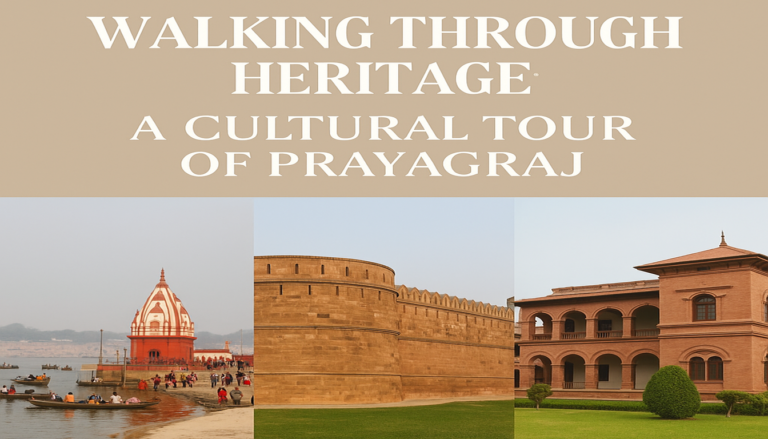Once known as Allahabad and now restored to its ancient name Prayagraj, this city at the confluence of the Ganga, Yamuna, and the mystical Saraswati is not just a geographical wonder, but a treasure trove of cultural and historical legacy. A cultural tour of Prayagraj is a walk through centuries of tradition, faith, politics, and architecture.
1. Triveni Sangam – The Sacred Confluence
The journey begins at Triveni Sangam, where the three holy rivers meet. This spot is the heart of spiritual Prayagraj, especially during Kumbh Mela, one of the world’s largest religious gatherings.
Location : https://maps.app.goo.gl/JbPH6DbYSv6NghDo8
What to experience:
-
Boat ride to the actual confluence point
-
Morning and evening aarti
-
Pilgrims performing holy dips

2. Allahabad Fort – The Mughal Marvel
Built by Emperor Akbar in 1583, the Allahabad Fort stands majestically near Sangam. Though entry is restricted due to army control, visitors can explore key sections like:
-
Ashoka Pillar
-
Patalpuri Temple
-
Akshayavat Tree (the immortal banyan tree)
Fun Fact: The fort houses underground temples and secret passageways believed to connect with Varanasi
 .
.
3. Anand Bhavan – A Cradle of Freedom
The ancestral home of the Nehru-Gandhi family, Anand Bhavan is now a museum showcasing:
-
Personal belongings of Nehru family
-
Photographs from the freedom struggle
-
Congress meeting rooms
Next door is Swaraj Bhavan, where Indira Gandhi was born and numerous freedom fighters once planned India’s independence.

4. Chandrashekhar Azad Park (Alfred Park)
This sprawling colonial-era park witnessed the heroic last stand of Chandrashekhar Azad. Today, it features:
-
A memorial statue of Azad
-
Public Library building
-
Lush green walking trails
Perfect for those who want to enjoy nature while immersing themselves in history.

5. Khusro Bagh – Mughal Serenity
This walled garden contains the tombs of Prince Khusro and his family. The Mughal architecture, floral motifs, and sandstone carvings make it an architectural gem.
Tip: Visit around sunset for beautiful photographs and a peaceful ambiance.

6. Allahabad University – The Academic Legacy
Nicknamed the “Oxford of the East,” Allahabad University has a rich intellectual heritage. Walking through its heritage buildings offers a glimpse into the academic and political minds of early modern India.

7. Local Bazaars and Street Food
Complete your cultural experience with a stroll through:
-
Chowk Bazaar – for traditional items and fabrics
-
Civil Lines – modern shops and colonial charm
-
Katra – a local hotspot for food lovers
Must-try dishes: Chaat, Tamatar ki chaat, Raj Kachori, and Kulfi Faluda.
How to Reach Prayagraj
By Air:
-
Prayagraj Airport (IXD) connects with major Indian cities like Delhi, Mumbai, and Bengaluru.
-
Airport is 12 km from the city center.
By Train:
-
Prayagraj Junction is a major railway hub with direct trains from all metro cities.
-
Other nearby stations: Prayag Junction, Naini, Subedarganj
By Road:
-
Well-connected via NH-2 and NH-30.
-
Regular UPSRTC and private buses from Varanasi, Lucknow, Kanpur.
Local Transport:
Auto-rickshaws, e-rickshaws, cabs, and app-based taxis (Ola, Uber) are easily available.
FAQs – Walking Through Heritage: Prayagraj
Q1. What is the best time to visit Prayagraj for a heritage walk?
A: October to March is ideal due to the pleasant weather. If you want to witness the Kumbh or Magh Mela, check dates for those specific years.
Q2. Is Prayagraj safe for solo travelers or foreign tourists?
A: Yes, Prayagraj is generally safe. Just follow common safety practices, avoid late-night solo walks in isolated areas, and use registered transport services.
Q3. Are guided heritage tours available in Prayagraj?
A: Yes, local tourism offices and private tour operators offer guided walks around Triveni Sangam, the Fort area, and Anand Bhavan. You can also find audio-guided apps and freelance guides near tourist spots.
Q4. How many days are enough to explore Prayagraj?
A: A well-planned 2 to 3-day trip is sufficient to cover the major cultural and historical sites.
Q5. Is photography allowed at all monuments?
A: Photography is allowed at most sites, but restrictions apply inside Anand Bhavan and some sections of the Fort. Always check signage or ask officials.
Conclusion: A Soulful Walk Through Time
A walk through Prayagraj is a spiritual, historical, and cultural pilgrimage. Whether you’re standing at the holy confluence, walking in the footsteps of freedom fighters, or exploring centuries-old Mughal tombs, you’ll leave with a deeper understanding of India’s heritage. Let Prayagraj speak to your soul—one step at a time.
For more Blogs : https://prayagdarshan.org/blogposts/



